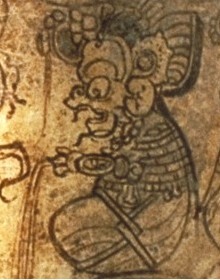resources
Teacher's Resources - The Hero Twins and the Lords of Death

How did this world begin? This question has been asked by every culture, and we have a version of the way the Maya, answered it in the Popul Vuh, the creation story of the K'iché Maya people of Guatemala. A 16th century copy of the Popul Vuh that was discovered in the 1850s tells us how the ball game in Mesoamerica acted as a metaphor for the game of life and death, of fate and of war. Here is a brief synopsis of the origin of humans according to the Popul Vuh.
The first part of the Popul Vuh tells the story of the great Maker and Modeller who created the world out of the primordial sea and sky. The Maker created life to nourish the gods, who are fed with prayers. After many attempts, humans were considered the pinnacle of creation because of their ability to speak (and pray) and master their surroundings
The second part deals largely with the adventures of the Hero Twins, Xbalanque (sh-bah-len-kay) and Hunahpu (hoon-ah-puu). Before their birth, their father, Hun Hunahpu (hoon hoon-ah-puu), and their uncle, enraged the gods of Xibalba (shi-ball-bah), the underworld, with their constant, noisy ball playing. The gods and demons challenged them to face a series of trials including a ball game in the underworld, which they lost due to the trickery of the lords of Xibalba. Their penalty for loss was death.
The severed head of Hun Hunahpu managed to father twins, however- the Hero Twins, who similarly disturbed Xibalba with ball playing. They were subjected to the same challenges as their father, but they outwitted the gods and turned the tables on them. After a series of tricks, they managed to kill one of the gods and vanquish the rest. After restoring the honour of their father and uncle, they turned themselves into the sun and the moon to watch over and be worshipped by the people.
Another origin story from Yucatan is recorded in the Books of the Chilam Balam (jaguar priest in the Mayan language). These books were made just after the Spanish conquest in 1519-49. They are written with the Latin alphabet that the Spanish monks and friars adapted to Maya. As in the Popul Vuh, the Plumed Serpent gives birth to the world, and the books describe the cyclical nature of all things, greater and lesser cycles of time following each other, life arising out of death and ending again in death.
In the Andean region, Viracocha, the supreme deity of the Inkas, was a storm god and a sun god who wore the sun for a crown. He wandered the earth as a beggar and wept when he saw the plight of the creatures he had created. Viracocha made the earth, the stars and mankind, but his first creation displeased him so he destroyed it with a flood and made a new, better one. Viracocha eventually disappeared across the Pacific and never returned.
Mesoamerican Ball Game
Ball courts are found throughout Mesoamerica. The ball game probably originated in the first millennium B.C., perhaps in the Valley of Mexico, and everywhere it was seen not as sport but as a means of predicting or controlling the future.
Although the rules and the courts varied greatly from place to place, the game was always played in a sacred space, and players were usually noblemen and/or warriors who were highly respected and well trained. In many instances, the game was played with a solid rubber ball, which was heavy enough to require that the players wear protective gear. In some cultures players dedicated themselves entirely to practicing the game and preparing for matches, but in others war captives were forced to play the game. Some groups sacrificed the losing team, and in some places all of the possessions of onlookers were the prizes for the team that emerged victorious.
Classroom Activities and Projects (recommended ages are in italics and are approximate)
1. 9 -14 : Draw a Mesoamerican ballplayer with the kinds of clothing and decorations you see worn by the Nayarit Ballplayer and the figures on the Cacao Vessel. Then right beside it draw a contemporary player of a ball sport (baseball, basketball, soccer, volleyball, etc.). Compare and contrast the kinds of equipment and decoration, using these criteria: design, function, physical conditions, cultural significance.
2. 9 -14: Research and compare origin myths from other cultures, for example, European, Middle Eastern, Indian.
3. 8 - 12: Try playing the game of Mesoamerican ball with a volleyball or lightweight ball. Pad the players' middles with towels and improvise a goal, perhaps a chalk line on a brick wall or a line of masking tape on the gym wall.